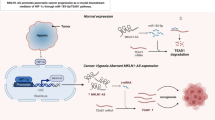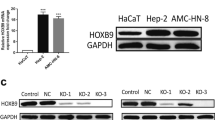Abstract
In this study, we explored the role of circ_CSPP1 in non-small cell lung cancer (NSCLC) using NSCLC cell lines (A549 and H1299) and human bronchial epithelioid cells (16HBE). The differential expression of circ_CSPP1, miR-486-3p and BRD9 in NSCLC by quantitative real-time polymerase chain reaction (qRT-PCR) and western blot in A549 cells, H1299 cells, 16HBE cells, NSCLC tissues and healthy lung tissues. Dual-luciferase reporter assay was conducted to verify the interaction between circ_CSPP1 and miR-486-3p or miR-486-3p and BRD9. The effect of circ_CSPP1/miR-486-3p/BRD9 axis on NSCLC cell proliferation was evaluated using cell counting kit-8 assay, colony formation assay, and 5-ethynyl-2′-deoxyuridine assay. Additionally, transwell assays were performed to evaluate the effect of circ_CSPP1/miR-486-3p/BRD9 axis on A549 and H1299 cell migration and invasion. The effect of circ_CSPP1 on tumor tumorigenesis of A549 cells in vivo was determined by xenograft tumor model and immunohistochemistry assay. Circ_CSPP1 and BRD9 expression were upregulated, while miR-486-3p expression was downregulated in tumor tissues of NSCCL patients and A549 and H1299 cells. Circ_CSPP1 specifically bound miR-486-3p, and miR-486-3p could target BRD9. Circ_CSPP1 upregulation promoted proliferation, invasion and migration of NSCLC cells, circ_CSPP1 knockdown or miR-486-3p upregulation had the opposite effects. Circ_CSPP1 knockdown-induced effects were reverted by miR-486-3p inhibition. Similarly, the effects of miR-486-3p upregulation on NSCLC cell proliferation, invasion and migration were reversed by BRD9 overexpression. In addition, circ_CSPP1 silencing inhibited tumor growth in nude mice. Circ_CSPP1 promoted A549 and H1299 cell malignancy by competitively inhibiting BRD9 and binding to miR-486-3p.










Similar content being viewed by others
References
Alpsoy A, Utturkar SM, Carter BC, Dhiman A, Torregrosa-Allen SE, Currie MP, Elzey BD, Dykhuizen EC (2021) BRD9 is a critical regulator of androgen receptor signaling and prostate cancer progression. Cancer Res 81(4):820–833
Bach DH, Lee SK, Sood AK (2019) Circular RNAs in cancer. Mol Ther Nucleic Acids 16:118–129
Borran S, Ahmadi G, Rezaei S, Anari MM, Modabberi M, Azarash Z, Razaviyan J, Derakhshan M, Akhbari M, Mirzaei H (2020) Circular RNAs: new players in thyroid cancer. Pathol Res Pract 216(10):153217
Brien GL, Remillard D, Shi J, Hemming ML, Chabon J, Wynne K, Dillon ET, Cagney G, Van Mierlo G, Baltissen MP, Vermeulen M, Qi J, Frohling S, Gray NS, Bradner JE, Vakoc CR, Armstrong SA (2018) Targeted degradation of BRD9 reverses oncogenic gene expression in synovial sarcoma. Elife 7
Cai X, Lin L, Zhang Q, Wu W, Su A (2020) Bioinformatics analysis of the circRNA-miRNA-mRNA network for non-small cell lung cancer. J Int Med Res 48(6):300060520929167
Chen HH, Zhang TN, Wu QJ, Huang XM, Zhao YH (2021) Circular RNAs in lung cancer: recent advances and future perspectives. Front Oncol 11:664290
Dou C, Sun L, Wang L, Cheng J, Wu W, Zhang C, Xu Q, Tu K, Liu J (2020) Bromodomain-containing protein 9 promotes the growth and metastasis of human hepatocellular carcinoma by activating the TUFT1/AKT pathway. Cell Death Dis 11(9):730
Fathi Z, Syn NL, Zhou JG, Roudi R (2018) Molecular epidemiology of lung cancer in Iran: implications for drug development and cancer prevention. J Hum Genet 63(7):783–794
Geng QQ, Wu QF, Zhang Y, Zhang GJ, Fu JK, Chen NZ (2020) Clinical significance of circ-MTHFD2 in diagnosis, pathological staging and prognosis of NSCLC. Eur Rev Med Pharmacol Sci 24(18):9473–9479
Hao Y, Xi J, Peng Y, Bian B, Hao G, Xi Y, Zhang Z (2020) Circular RNA Circ_0016760 modulates non-small-cell lung cancer growth through the miR-577/ZBTB7A axis. Cancer Manag Res 12:5561–5574
He J, Xie Q, Xu H, Li J, Li Y (2017) Circular RNAs and cancer. Cancer Lett 396:138–144
Hong W, Xue M, Jiang J, Zhang Y, Gao X (2020) Circular RNA circ-CPA4/ let-7 miRNA/PD-L1 axis regulates cell growth, stemness, drug resistance and immune evasion in non-small cell lung cancer (NSCLC). J Exp Clin Cancer Res 39(1):149
Huang H, Wang Y, Li Q, Fei X, Ma H, Hu R (2019) miR-140-3p functions as a tumor suppressor in squamous cell lung cancer by regulating BRD9. Cancer Lett 446:81–89
Jia N, Song Z, Chen B, Cheng J, Zhou W (2021) A novel circular RNA circCSPP1 promotes liver cancer progression by sponging miR-1182. Onco Targets Ther 14:2829–2838
Jones GS, Baldwin DR (2018) Recent advances in the management of lung cancer. Clin Med (lond) 18(Suppl 2):s41–s46
Kayser G (2015) Non-small cell lung cancer. New biomarkers for diagnostics and therapy. Pathologe 36(Suppl 2):189–193
Li DY, Chen WJ, Luo L, Wang YK, Shang J, Zhang Y, Chen G, Li SK (2017) Prospective lncRNA-miRNA-mRNA regulatory network of long non-coding RNA LINC00968 in non-small cell lung cancer A549 cells: a miRNA microarray and bioinformatics investigation. Int J Mol Med 40(6):1895–1906
Li S, Teng S, Xu J, Su G, Zhang Y, Zhao J, Zhang S, Wang H, Qin W, Lu ZJ, Guo Y, Zhu Q, Wang D (2019) Microarray is an efficient tool for circRNA profiling. Brief Bioinform 20(4):1420–1433
Li M, Zhuang J, Kang D, Chen Y, Song W (2021a) Identification of circRNA circ-CSPP1 as a potent driver of colorectal cancer by directly targeting the miR-431/LASP1 axis. Open Life Sci 16(1):523–536
Li Z, Huang X, Liu A, Xu J, Lai J, Guan H, Ma J (2021b) Circ_PSD3 promotes the progression of papillary thyroid carcinoma via the miR-637/HEMGN axis. Life Sci 264:118622
Liu Y, Zhang J, Xing C, Wei S, Guo N, Wang Y (2018) miR-486 inhibited osteosarcoma cells invasion and epithelial-mesenchymal transition by targeting PIM1. Cancer Biomark 23(2):269–277
Liu S, Zhan Y, Luo J, Feng J, Lu J, Zheng H, Wen Q, Fan S (2019) Roles of exosomes in the carcinogenesis and clinical therapy of non-small cell lung cancer. Biomed Pharmacother 111:338–346
Lloyd JT, Glass KC (2018) Biological function and histone recognition of family IV bromodomain-containing proteins. J Cell Physiol 233(3):1877–1886
Misir S, Hepokur C, Aliyazicioglu Y, Enguita FJ (2020) Circular RNAs serve as miRNA sponges in breast cancer. Breast Cancer 27(6):1048–1057
Pena-Philippides JC, Gardiner AS, Caballero-Garrido E, Pan R, Zhu Y, Roitbak T (2018) Inhibition of MicroRNA-155 supports endothelial tight junction integrity following oxygen-glucose deprivation. J Am Heart Assoc 7(13):e009244
Planchard D, Popat S, Kerr K, Novello S, Smit EF, Faivre-Finn C, Mok TS, Reck M, Van Schil PE, Hellmann MD, Peters S (2019) Correction to: “metastatic non-small cell lung cancer: ESMO Clinical Practice Guidelines for diagnosis, treatment and follow-up.” Ann Oncol 30(5):863–870
Qi X, Zhang DH, Wu N, Xiao JH, Wang X, Ma W (2015) ceRNA in cancer: possible functions and clinical implications. J Med Genet 52(10):710–718
Shi J, Li D, Liang D, He Y (2021) Epidemiology and prognosis in young lung cancer patients aged under 45 years old in northern China. Sci Rep 11(1):6817
Wu P, Mo Y, Peng M, Tang T, Zhong Y, Deng X, Xiong F, Guo C, Wu X, Li Y, Li X, Li G, Zeng Z, Xiong W (2020) Emerging role of tumor-related functional peptides encoded by lncRNA and circRNA. Mol Cancer 19(1):22–22
Xie X, Li X, Tang W, Xie P, Tan X (2021) Primary tumor location in lung cancer: the evaluation and administration. Chin Med J 135(2):127–136
Xu P, Wang L, Xie X, Hu F, Yang Q, Hu R, Jiang L, Ding F, Mei J, Liu J, Xiao H (2020) Hsa_circ_0001869 promotes NSCLC progression via sponging miR-638 and enhancing FOSL2 expression. Aging (albany NY) 12(23):23836–23848
Yan X, Jiao SC, Zhang GQ, Guan Y, Wang JL (2017) Tumor-associated immune factors are associated with recurrence and metastasis in non-small cell lung cancer. Cancer Gene Ther 24(2):57–63
Yang H, Huang Y, He J, Chai G, Di Y, Wang A, Gui D (2020) MiR-486–3p inhibits the proliferation, migration and invasion of retinoblastoma cells by targeting ECM1. Biosci Rep 40(6)
Zhang H, Chen X, Yuan Y (2020a) Investigation of the miRNA and mRNA coexpression network and their prognostic value in hepatocellular carcinoma. Biomed Res Int 2020:8726567
Zhang ZY, Gao XH, Ma MY, Zhao CL, Zhang YL, Guo SS (2020b) CircRNA_101237 promotes NSCLC progression via the miRNA-490-3p/MAPK1 axis. Sci Rep 10(1):9024
Zhu X, Tian G, Quan J, He P, Liu J (2019) Effects of miR-340 overexpression and knockdown on the proliferation and metastasis of NSCLC cell lines. Int J Mol Med 44(2):643–651
Zhu X, Liao Y, Tang L (2020) Targeting BRD9 for cancer treatment: a new strategy. Onco Targets Ther 13:13191–13200
Acknowledgements
None.
Funding
This study doesn’t receive any financial support as well as any role of funding bodies.
Author information
Authors and Affiliations
Corresponding author
Ethics declarations
Conflict of interest
The authors declare that they have no conflicts of interest.
Additional information
Publisher's Note
Springer Nature remains neutral with regard to jurisdictional claims in published maps and institutional affiliations.
Supplementary Information
Below is the link to the electronic supplementary material.
10528_2022_10231_MOESM1_ESM.tif
Figure S1 Transfection efficiency of sh-circ_CSPP1 and circ_CSPP1 in A549 and H1299 cells. (A-B) The transfection efficiency of sh-circ_CSPP1 and circ_CSPP1 in A549 and H1299 cells was detected by qRT-PCR. Data were obtained from three independent and not replicated experiments. *P < 0.05. Supplementary file1 (TIF 98 kb)
10528_2022_10231_MOESM2_ESM.tif
Figure S2 The expression analysis of miRNAs and mRNAs. (A) The expression of the first six miRNAs with high circ_CSPP1-binding ability in circ_CSPP1-depleted A549 cells was detected by qRT-PCR. (B) The expression of mRNAs containing miR-486-3p-binding sites and participating in NSCLC progression after miR-486-3p overexpression was checked by qRT-PCR in A549 cells. Data were obtained from three independent and not replicated experiments.*P < 0.05. Supplementary file2 (TIF 339 kb)
10528_2022_10231_MOESM3_ESM.tif
Figure S3 The schematic illustration showing the mechanism by which circ_CSPP1 regulated NSCLC cell proliferation, migration and invasion. Supplementary file3 (TIF 166 kb)
Rights and permissions
About this article
Cite this article
Xie, D., Zhang, S., Jiang, X. et al. Circ_CSPP1 Regulates the Development of Non-small Cell Lung Cancer via the miR-486-3p/BRD9 Axis. Biochem Genet 61, 1–20 (2023). https://doi.org/10.1007/s10528-022-10231-6
Received:
Accepted:
Published:
Issue Date:
DOI: https://doi.org/10.1007/s10528-022-10231-6




